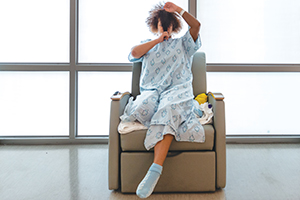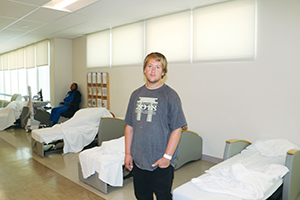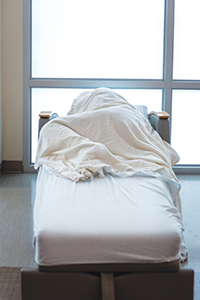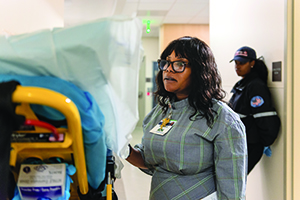By JULIE MINDA
SAN PEDRO, Calif. — On April 1, Justin Frye arrives at Providence Saint John's Health Center's emergency department in Santa Monica, Calif., after an evening of drinking. He is argumentative and aggressive with emergency department staff.

A patient in the Crisis Stabilization Unit of Providence Little Company of Mary Medical Center in San Pedro, Calif., early this year. Diagnosed with bipolar disorder and schizophrenia, the woman had been dancing on the roof and speaking gibberish when her mother called 911. She was transferred to the unit from a Los Angeles County emergency department. Heidi de Marco/KHN (@heidi_demarco)
Clinicians determine that Frye has no pressing medical issue; he is, however, in the throes of a psychiatric emergency. With Frye's consent, the hospital transfers him by ambulance to the Crisis Stabilization Unit of Providence Little Company of Mary Medical Center about 30 miles away in San Pedro.
Once he is here, a psychiatrist and a psychiatric nurse address his agitation and anxiety. A psychiatric social worker zeroes in on his ongoing socioeconomic needs.
His main goals, Frye tells this reporter, are to get sober — he's dependent on alcohol and methamphetamine. Crisis Stabilization Unit staff will connect him with local addiction treatment services and other referrals to community-based social services.
One of just three such facilities in Los Angeles County — the nation's most populous county — the unit serves as a pressure release valve for all the county's emergency departments. Those departments are "overwhelmed with psychiatric patients, because they pose a unique challenge in that their other chief complaints are difficult to address when they are in crisis," says Gilbert Dorado, director of behavioral health and care management at Providence Little Company of Mary Medical Center San Pedro.

Justin Frye in the Crisis Stabilization Unit of Providence Little Company of Mary Medical Center in San Pedro, Calif., at the start of April. He'd been transferred from a Santa Monica, Calif., emergency department. Julie Minda/© CHA
The stabilization unit offers a safe and medically appropriate alternative for the short-term stabilization of patients in psychiatric distress. This can include patients who are an immediate danger to themselves or others, experiencing psychosis, depression or acute anxiety.
Dorado, who is in charge of the stabilization unit, says the medical center opened the unit because psychiatric patients had been languishing in emergency departments that were ill-equipped to meet their needs.
Dorado says that in addition to an underlying psychiatric condition such as bipolar disorder or schizophrenia, many of the unit's patients have substance dependence disorders and are homeless.
One-and-done cures don't apply here. "Many communities don't want to address this, but Providence is addressing it. … While many other psychiatric services have been closing, we're expanding," he says.
Care continuum
Providence opened the 5,000-square-foot, freestanding outpatient center in late 2017. Providence St. Joseph Health's Well-Being Trust provided most of the start-up funding.
The stabilization unit treated about 800 patients in 2018. It can accommodate a dozen patients at a time; by next month it will be equipped for 20. Currently, the state's Medi-Cal Medicaid program and the California Department of Health Care Services' Mental Health Services Division provide most of the unit's funding.
Dr. Scott Zeller, chair of the National Coalition on Psychiatric Emergencies, told Kaiser Health News that there are about 100 units like this one nationwide.
Dorado says the stabilization unit at Little Company of Mary is part of the health system's continuum of mental health services. In Los Angeles County, Providence St. Joseph also has a 25-bed inpatient psychiatric department, a partial hospitalization program, a medical detoxification program, a psychiatric rehabilitation department and a range of other outpatient psychiatric services. The stabilization unit can refer its patients within Providence or to other providers in the community.
Racing the clock
Anya Price, clinical supervisor of the stabilization unit, says before a transfer patient arrives, staff has spoken to the referring emergency clinician and reviewed the patient's medical record.

A psychiatric patient sleeps on a convertible recliner in a centralized patient hub at the short-stay Crisis Stabilization Unit. Patients receive psychiatric care and referrals to social services and resources. The unit accepts psychiatric patients from all Los Angeles County emergency rooms.
Heidi de Marco/KHN (@heidi_demarco)
The intake evaluation in the stabilization unit includes an assessment of the patient's mood, thought processes, speech, memory and judgment. Currently, the psychiatrist conducting the assessment may be in-house or present via a telemedicine connection. Starting this summer, a psychiatrist will be at the facility around the clock.
The psychiatrist commonly prescribes such medications as antidepressants, sleep aids, antipsychotics and sometimes antibiotics and non-opioid pain drugs. Nurses administer the medications and provide therapeutic communication throughout patient stays. Patients are given the opportunity to shower, eat and rest. If need be, staff launder the patients' clothes on-site.
Behind the scenes, staff are often in a race against time, Dorado says. Social workers complete an assessment and help connect patients with resources, trying to arrange beds at shelters, sober living facilities or transitional living facilities; transportation; and connections with outpatient counseling and other services, before the discharge that happens within 23 hours of admission to the unit.
Price says 20 percent of patients will be transferred to an inpatient psychiatric facility. The rest will be referred for outpatient care.
Comforting environment
Zeller, a vice president of acute psychiatry at Vituity, a health care consultancy and physician staffing service, guided Providence in the unit's development. He consulted on the physical design of the space as well as the processes, protocols and operational aspects of the unit, explains Dorado.

Nurse Anya Price, clinical supervisor, talks to a new patient about the procedures at the Crisis Stabilization Unit.
Heidi de Marco/KHN (@heidi_demarco)
The unit includes several private rooms for completing intake, calming agitated patients and conducting confidential discussions. The locus of activity is a central patient care hub, an open room where patients can lounge or sleep. There are about two dozen cushioned recliners positioned throughout the room. Clinical staff spend much of their time interacting with patients in the common room, and just a small portion of their time at the nurses' desk, which has a clear line of sight to all the recliners.
The hub has the feel of a living room. Walls are painted in neutral and muted hues and large windows let in natural light. Several televisions are on, with the volume turned down low. Private bathrooms with showers can be accessed from the hub. There's a kitchenette where patients help themselves to snacks, fruit, vegetables and cereals or a microwavable frozen meal.
All patient areas in the locked unit are designed to prevent patients from harming themselves — poles have padding, fixtures cannot be tampered with, kitchen utensils are blunt, plants in the outdoor healing garden are all edible.
The patients' time at the unit is mostly unscheduled and unstructured, says Dorado, and many patients are surprised to have this freedom. "Most inpatient psychiatric units are rigid and structured. Here, we try to give some control back to the patients."
Frye says of the atmosphere, "It feels good here. It is laid back. It is awesome."
Easy does it
Kelly Till, a unit nurse, says "patients say it's great here because they weren't doing too well in the emergency department — there was too much stimulation there for them. It is often loud, and chaotic, and medical emergencies take precedence. Here, it is quiet."
Dorado says the unit's work holds the promise to reduce unnecessary hospital admissions for people with chronic psychiatric disorders.
Price adds, "Maybe we can't cure people" during their brief stay, "but maybe we can restore their faith in humanity while we get them some services."